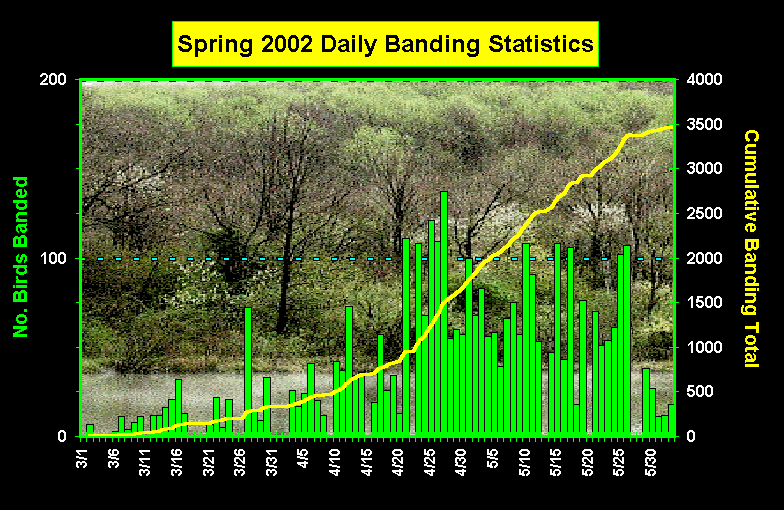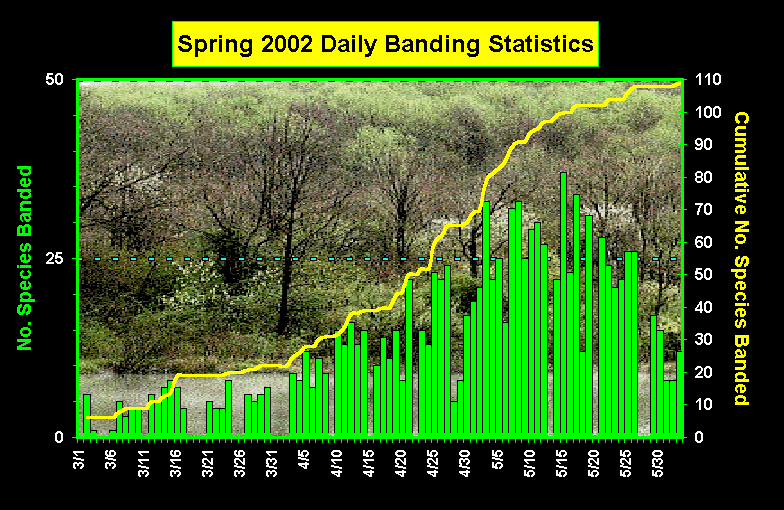
The bird-banding program at Powdermill Nature Reserve, the 2,000 acre biological station of Carnegie Museum of Natural History located in the Laurel Highlands region of southwestern Pennsylvania, was in operation on 77 out of a possible 94 days during the spring 2002 season (March through June 2). Spring 2002 was a clear improvement over spring 2001, which was one of our poorest migration banding seasons in 40 years (Table 1).
| 2002 | 2001 | |
| No. Net Hours |
|
|
| No. Birds Banded |
|
|
| No. Birds Banded/100 Net Hours |
|
|
| No. Recaptures |
|
|
| No. Species Banded |
|
|
The 3,475 birds banded this spring is the highest spring total since 1990 and our eighth highest ever (highest ever spring total was 4,648 in 1973). The average spring banding total over the last 40 years is 2,731--this year's total was almost one standard deviation above average.


Highlights of the season were our third ever Clay-colored Sparrow and our fifth Prothonotary Warbler. Notwithstanding the high species diversity this spring, some conspicuous "misses" this spring (i.e., species with a long-term average of at least one banded in spring) included Sharp-shinned Hawk, Yellow-bellied Sapsucker, Olive-sided Flycatcher, Great Crested Flycatcher, Yellow-throated Vireo, Cape May Warbler, Blackburnian Warbler, Prairie Warbler, Savannah Sparrow, and Evening Grosbeak.
Totals for all species banded this spring are given in descending order in Table 2 below. Without question, the bird of the season was American Goldfinch--this spring's total of 829 AMGOs easily eclipsed our previous high spring total of 674 set in 1971. Only a few other species were banded in record high numbers this spring, and most of these edged out the previous record by just one or two birds: Carolina Wren (4 banded in 2002/previous record total was 2, i.e., 4/2); Hermit Thrush (6/5); "Yellow" Palm Warbler (2/1); Hooded Warbler (27/26); Common Grackle (61/46). Other species with well above average flights this spring included "Traill's" Flycatcher, Wood Thrush, Brown Thrasher, Cedar Waxwing, Yellow Warbler, Magnolia Warbler, Chestnut-sided Warbler, Northern Waterthrush (35 banded--one shy of the record high spring total for the species), Red-winged Blackbird, and Orchard Oriole (5 banded--one fewer than the record total).
| SPECIES | Spring 2002
Banding Totals |
| American Goldfinch | 829 |
| Dark-eyed Junco | 236 |
| Ruby-crowned Kinglet | 176 |
| Cedar Waxwing | 166 |
| Magnolia Warbler | 136 |
| Chipping Sparrow | 115 |
| Song Sparrow | 115 |
| Gray Catbird | 85 |
| Purple Finch | 82 |
| Red-eyed Vireo | 67 |
| Blue Jay | 65 |
| Red-winged Blackbird | 63 |
| Yellow Warbler | 61 |
| Common Grackle | 61 |
| Ruby-throated Hummingbird | 59 |
| Common Yellowthroat | 59 |
| Fox Sparrow | 58 |
| Swamp Sparrow | 51 |
| Black-capped Chickadee | 49 |
| Swainson's Thrush | 41 |
| Tennessee Warbler | 40 |
| White-throated Sparrow | 36 |
| Northern Waterthrush | 35 |
| Indigo Bunting | 32 |
| Traill's (Willow or Alder) Flycatcher | 31 |
| Canada Warbler | 30 |
| Wilson's Warbler | 29 |
| Least Flycatcher | 28 |
| American Redstart | 28 |
| Field Sparrow | 28 |
| Wood Thrush | 27 |
| Hooded Warbler | 27 |
| Golden-crowned Kinglet | 24 |
| House Finch | 23 |
| Louisiana Waterthrush | 22 |
| Chestnut-sided Warbler | 21 |
| Brown-headed Cowbird | 21 |
| Barn Swallow | 19 |
| Eastern Towhee | 19 |
| Nashville Warbler | 18 |
| Northern Cardinal | 18 |
| Ovenbird | 17 |
| Philadelphia Vireo | 16 |
| American Robin | 14 |
| Yellow-rumped Warbler | 14 |
| Mourning Warbler | 14 |
| Black-and-white Warbler | 12 |
| Pine Siskin | 12 |
| Tufted Titmouse | 11 |
| House Wren | 11 |
| Brown Thrasher | 10 |
| Eastern Phoebe | 9 |
| Blackpoll Warbler | 9 |
| Kentucky Warbler | 9 |
| Rose-breasted Grosbeak | 9 |
| Baltimore Oriole | 9 |
| Blue-gray Gnatcatcher | 8 |
| Yellow-bellied Flycatcher | 7 |
| White-eyed Vireo | 7 |
| Tree Swallow | 7 |
| Veery | 7 |
| Solitary Sandpiper | 6 |
| Eastern Wood-Pewee | 6 |
| Northern Rough-winged Swallow | 6 |
| Hermit Thrush | 6 |
| Lincoln's Sparrow | 6 |
| White-breasted Nuthatch | 5 |
| Gray-cheeked Thrush | 5 |
| Blue-winged Warbler | 5 |
| White-crowned Sparrow | 5 |
| Orchard Oriole | 5 |
| Mourning Dove | 4 |
| Downy Woodpecker | 4 |
| Acadian Flycatcher | 4 |
| Carolina Wren | 4 |
| Yellow-billed Cuckoo | 3 |
| Northern Flicker | 3 |
| Warbling Vireo | 3 |
| Brown Creeper | 3 |
| Orange-crowned Warbler | 3 |
| Black-throated Blue Warbler | 3 |
| Scarlet Tanager | 3 |
| Rusty Blackbird | 3 |
| American Woodcock | 2 |
| Belted Kingfisher | 2 |
| Blue-headed Vireo | 2 |
| Winter Wren | 2 |
| Golden-winged Warbler | 2 |
| "Brewster's" Warbler | 2 |
| Black-throated Green Warbler | 2 |
| "Western" Palm Warbler | 2 |
| "Yellow" Palm Warbler | 2 |
| Worm-eating Warbler | 2 |
| Yellow-breasted Chat | 2 |
| House Sparrow | 2 |
| Green Heron | 1 |
| Spotted Sandpiper | 1 |
| Black-billed Cuckoo | 1 |
| Red-bellied Woodpecker | 1 |
| Hairy Woodpecker | 1 |
| Eastern Kingbird | 1 |
| Carolina Chickadee | 1 |
| Eastern Bluebird | 1 |
| European Starling | 1 |
| Northern Parula | 1 |
| Pine Warbler | 1 |
| Bay-breasted Warbler | 1 |
| Prothonotary Warbler | 1 |
| Clay-colored Sparrow | 1 |
| ALL SPECIES COMBINED | 3,475 |
To compare our 2002 total for any species with last spring's total and the long-term (40-yr.) average, go to the appropriate species group summary:
Waterbirds
through Woodpeckers
1
Flycatchers
through Swallows
2
Chickadees
through Waxwing
3
Wood
Warblers
4
Tanager
through Finches
5
Last, but not least, we owe many thanks to the following volunteers, interns, and others who helped us with the banding this spring: Marilyn Niedermeier, Adrienne Leppold, Brian Jones, Annie Lindsay, Amy Cunkelman, Jim Gruber, Mary Helen Chiodo, Randi Gerrish, Don, Jordin, and Carol Schober, Carole Shanahan, Jami Paul, Joe Merritt, Jamie Fischer, Joe Schreiber, Kevin Georg, George Hall, and Larry Barth.